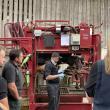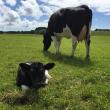We wanted to improve our overall cow health and mobility, so we worked together with Advanced Nutrition. Their Advanced Mobility program helped to give us a true understanding of the lameness and mobility issues we had within the herd.
Producers urged to optimise nutrition to prevent lameness
There’s a identified link between nutrition and lameness - some practical approaches are helping dairy farmers to improve herd hoof health. British Dairying finds out more.

Lameness in dairy cattle remains a critical concern, affecting both the welfare of animals and their production capabilities. In England and Wales, prevalence rates hover around 36.8%, and lameness ranks among the top three challenges in dairy cow health. Sitting behind mastitis and reproduction issues, it is the third most expensive disease to treat. Beyond the direct costs of treatment and veterinary care, it also has a knock-on effect on milk production and calving intervals.
“We don’t often connect these additional expenses, with cows ending up on a cull list, as actually originating from a lameness issue,” says Scott Carter, Southern Technical Manager at Advanced Ruminant Nutrition.
Studies indicate that lameness costs range from £110 to £400/case. Alarmingly, the Burger study suggests that a significant portion of production disease costs – up to 27% – can be attributed to lameness issues alone. The question of how nutrition influences lameness is something that Scott hears a lot from dairy farmers seeking to optimise production. “Working collaboratively with the whole farm team, we recognise the critical role nutrition plays in promoting healthy hoof growth,” he says. “It is one of the basic preventative factors affecting the quality and growth of hoof horn, and associated hoof disease. The key word here is preventative… it’s essential to recognise that nutrition is just one piece of the puzzle.
“However, although physical factors like environment and trimming routines are more commonly associated with lameness, we can’t overlook nutrition. A well-balanced diet, rich in essential nutrients, is fundamental to fostering robust hoof health.”
Balanced approach required
There are key nutritional elements to consider. “Minerals, vitamins, amino acids, and fatty acids all contribute to the structural integrity of hooves,” says Scott. “Most of these play key roles in the keratinisation process, which ensures healthy horn growth.” Nutrients which are necessary for keratin production include amino acids, fatty acids, minerals (especially calcium), and trace elements and vitamins. Imbalances in minerals and vitamins, as well as other nutritional deficiencies, can lead to the growth of a fragile horn, which may be more prone to cracks and infections. “What we are essentially trying to achieve when looking at this part of a cow’s diet is to secure healthy horn growth, to create a hoof that is better able to manage with the physical challenges facing a modern dairy animal, in both grazing and housed systems,” explains Scott.
Other core elements of the diet include fibre and rumen balance, as well as a balanced approach to feeding concentrates. Concentrates containing high starch, (cereal, ground maize, etc), as well as sugar sources like molasses, create an acidic rumen environment when fermented by rumen microbes. Acids in the rumen can damage the gastrointestinal lining and create localised or systemic inflammation, which can travel outside of the rumen. Diet changes and lower rumen pH can also cause a shift in rumen microbial populations, which may favour species like Treponema, which play a role in digital dermatitis.
“By carefully formulating the diet and monitoring cow health, we can limit occurrence of hoof health issues caused by nutritional imbalance and mismanagement,” he claims. “Avoiding clinical or sub-acute rumen acidosis is important for the same reasons. The situations that upset rumen health and most commonly lower rumen pH have a negative effect on foot health.”
Awareness of toxins
Another consideration is toxins. Most commonly, but not exclusively, found in mouldy feed, toxins challenge the rumen. When sources of toxins are fed, histamine and other endotoxins are released into the blood, which can cause vasodilation, ultimately damaging the network of blood vessels in the hoof dermis, says Scott. “Subsequently, there is an insufficient supply of oxygen and amino acids, which are necessary for the formation of the hoof tissues; a precursor or gateway to many more problems including laminitis.
“So, we have plenty to think about when it comes to taking a balanced and proactive approach to feeding cows to prevent lameness. But we also know that lameness affects how diets perform, including lower dry matter intakes, energy drain to deal with pain, and subtle changes in cow behaviour – which is particularly relevant on farms with automated milking systems,” Scott explains.
“So, it works both ways: nutrition can have a positive effect on lameness, but lameness that is already present has a huge, detrimental effect on the outcome of a cow’s diet.”
〈 BACK




